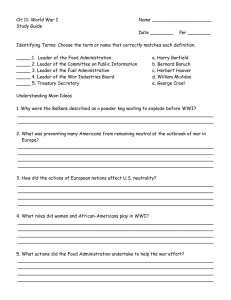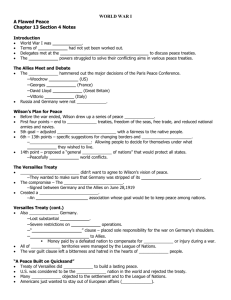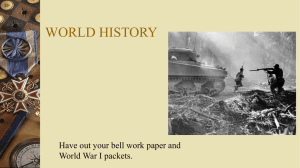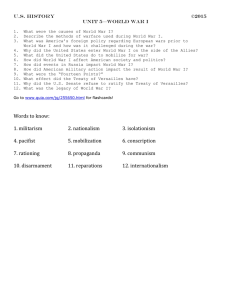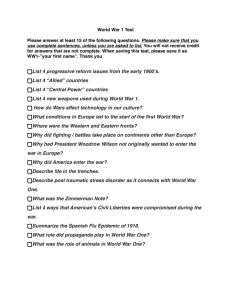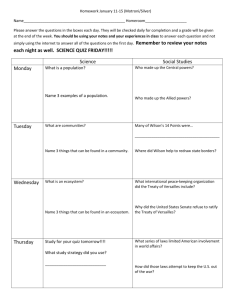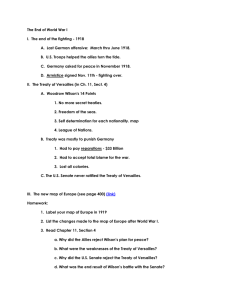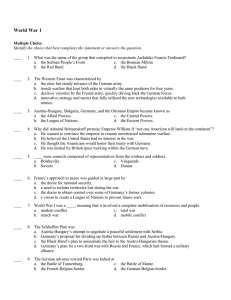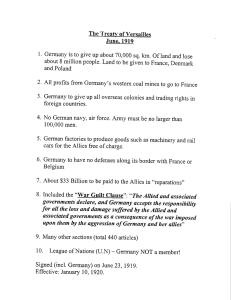Treaty of Versailles
advertisement
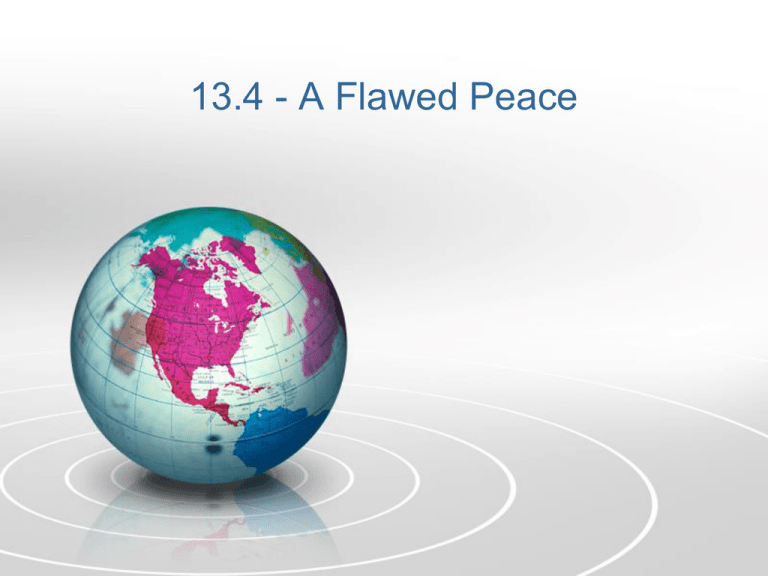
13.4 - A Flawed Peace German generals recognized that it was time to sue for peace with the Allies. The Kaiser was forced to abdicate on the 8th November and a new democratic republic was established. An armistice (an agreement to stop fighting) is signed in a railway car near Paris. On November 11, 1918, World War I came to an end. A Flawed Peace 13.4 How would the Allies deal with a defeated Germany? David Lloyd-George [Great Britain] The Big Four Vittorio Orlando [Italy] Woodrow Wilson [USA] Georges Clemenceau [France] “I can predict with absolute certainty that within another generation there will be another world war if the nations of the world do not concert the method by which to prevent it." Woodrow Wilson, 1919 Differing Allied Goals • America, Woodrow Wilson – Fourteen Points: • Plan for organizing post-World War I Europe & avoiding future wars – Reduction of weapons – Self Determination-right of all people to choose their own governments (democracies) – Organization for world’s nations to join, to protect from future aggression Differing Allied Goals • France, Georges Clemenceau – punish Germany – make Germany pay for costs of war • Great Britain, David Lloyd George – punish Germany – don’t weaken Germany • wanted Germany to stop communism from spreading out of Russia • Italy, Vittorio Orlando – wanted to gain territory -Italy was essentially ignored Treaty of Versailles • Allies finally compromised on goals • Treaty of Versailles was closer to Clemenceau’s goals than Wilson’s • Germany had to accept the terms of the treaty http://www.history.com/topics/ world-war-i/videos#treaty-ofversailles-end-world-war-i Copy the chart! Treaty of Versailles (1919) •Designed to cripple Germany WAR GUILT CLAUSE GERMANY’S MILITARY FORCES REDUCED NO UNION WITH AUSTRIA PAY REPARATIONS THE TERMS OF THE TREATY OF VERSAILLES 1919 RHINELAND DE-MILITARISED LOSS OF TERRITORRY The War Guilt Clause "The Allied and Associated Governments affirm, and Germany accepts, the responsibility of Germany and her Allies for causing all the loss and damage to which the Allied and Associate Governments and their nationals have been subjected as a consequence of a war imposed upon them by the aggression of Germany and her Allies." Article 231 Treaty of Versailles • June 28, 1919 signed by Germany • League of Nations formed: – International body of nations – Purpose: to prevent future wars – Germany was excluded – U.S. did not join 1. Describe the storyline, What is being represented by the ‘hand’? 2. Assess the individual features. 3. Identify the political message intended by the cartoonist. ‘Who’ or ‘what’ is the man representing? What does the plank represent THE FINISHING TOUCH A British newspaper cartoon, by David Low. 1) Describe the storyline shown in the cartoon. 2) Assess the individual features. 3) What is the political message? What does the horse represent? What is this referring to? Briand, French Prime Minister Why is the cart up-ended? Why is a shovel left here? Why is Briand holding a whip? ‘Perhaps ‘Perhaps it it would would gee-up gee-up better better if if we we let let it it touch touch earth.’ earth.’ What is meant by the caption? Why is Lloyd-George holding a shovel? Lloyd-George, British Prime Minister Causes of WWI •Militarism •Alliance System •Nationalism •Imperialism •Assassination of Franz Ferdinand Effects of WWI •Allied victory •Boom in American economy •Colonies lost for defeated empires •Destruction in Europe •Emergence of U.S. as a world leader & economic giant

